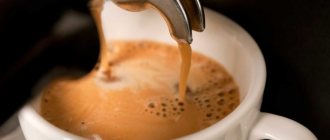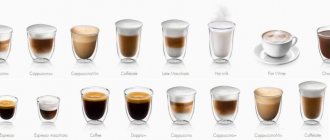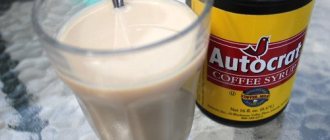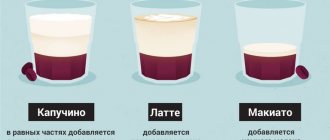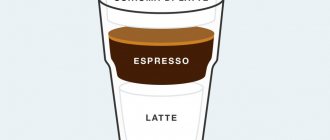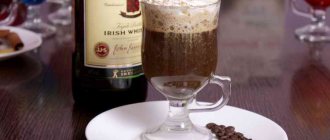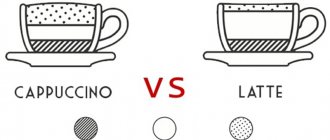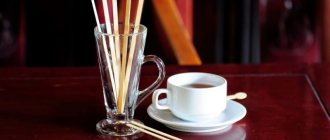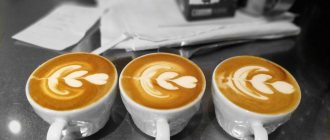There are many varieties of coffee, so everyone can find a drink to their liking. For those who like stronger coffee, ristretto is perfect, and for connoisseurs of a mild taste, they came up with Americano. For ice cream lovers, you can make ice cream.
All these drinks have one thing in common - they are made on the basis of espresso. In this article you will learn what types of coffee there are and what is included in their recipes.
Espresso
There are many definitions of espresso, some very narrow, others too broad. It would be correct to say that espresso is a coffee drink that is small in volume, strong and prepared from finely ground beans under high water pressure. Also, espresso should have crema (i.e. foam). To be even more precise, we note that the ratio of the weight of ground coffee to the weight of the finished drink should be approximately 1: 2. But it is better to leave the definition of espresso and the methods of its preparation open than to correct others: everyone has the right to have their own opinion on this matter.
Types of coffee cocktails
All cocktails that use coffee in their preparation are divided into the following varieties:
- non-alcoholic;
- alcoholic;
- hot;
- cold;
- fruit;
- dairy
A classic option is the combination of coffee beans with chocolate and dairy products.
Based on these ingredients, you can prepare a hot and cold version of the drink. As a rule, when choosing one or another of them, the time of year is taken into account. On a hot summer day you want something refreshing, and on winter evenings, on the contrary, something warming.
Lungo
Lungo, or “long” coffee, until recently was considered extremely unpopular in the world of “specialty coffee”. It was prepared in a coffee machine, but using two or three times more water for the same amount of coffee to create a longer drink. As a result, the strength decreased. And although consumers enjoyed their drink longer, lungo was considered inferior in quality due to its lack of body and aftertaste. However, recently a new trend has emerged among the “specialty” coffee scene - brewing lungo with light-roasted beans. As a result, we get a complex and balanced drink that can be very tasty. If you can't achieve the desired acidity in your espresso, try making a longer drink by adding more water for the same amount of coffee. The grind should be coarser to allow the water to pass through faster and prevent over-extraction.
We are looking for ideas for signature drinks
Where might the idea for a signature drink come from? Here are some ways.
- Listen to the wishes of visitors. This way you can understand the direction of work. It’s difficult to come up with a new drink this way, but you can find out what signature drinks in other coffee shops visitors like.
- Visit other coffee shops. I'm not advocating repeating their recipes, but some interesting flavor combinations may inspire you to create something new.
- Experiment. Mix foods in interesting combinations. It is advisable to use ingredients that are already in the coffee shop, so creating a new drink will not lead to additional costs and the need to purchase additional raw materials.
Macchiato
This name implies that espresso is 'about milk foam. In a busy Italian coffee shop, you can often see the barista placing espresso cups in a row on the bar counter. One of the visitors may ask for an espresso with a drop of milk, and then it is important to add a little milk foam and not forget whose cup it is. If you pour a little milk into freshly brewed espresso, it will simply disappear under a layer of cream, and you will not be able to distinguish your drink from others. Over the past ten years, high-end coffee shops have come up with a new way to make macchiato: they turned it into espresso with frothed milk. This is often done when a client asks for a softer, sweeter drink and a larger quantity. However, sometimes the barista just likes to show off his skills and creates latte art on the surface of the coffee in each small cup. Starbucks added even more confusion with its caramel macchiato. This is a completely different drink, it is more like a latte coffee, which is “marked” with caramel syrup. This has confused some consumers, especially in North America, and the traditional macchiato is now available on coffee shop menus.
Testing signature drinks
First, we prepare the drink, try it ourselves and finalize the recipe. We force friends and acquaintances with different taste preferences to try it.
If almost everyone likes the drink, it’s too early to add it to the main menu; we move on to testing it on visitors.
evaluate the result after several months . How many times have you bought this drink? What were the reviews? Did the same people start buying the drink on a regular basis?
Then, based on the result, we either forget about the drink and start from the beginning, or we finalize it and introduce it to the seasonal menu in a year, or we introduce it to the main menu.
Cappuccino
There are many myths about cappuccino. Let’s dispel one of them right away: this name has nothing to do with either the hoods of monastic robes or the shorn top of the monks’ heads. The drink was invented in the 19th century in Vienna and was then called kapuziner. A little brewed coffee was mixed with milk or cream until it turned brown - the color of the Capuchin monks' robes. In fact, the name tells us about the strength of the drink. Another myth about cappuccino is the three-thirds rule. According to him, a classic cappuccino consists of three equal parts: espresso, milk and foam. The first mention of three-thirds dates back to the fifties of the 20th century. It described cappuccino as “espresso mixed with equal amounts of milk and foam.” This sentence is repeated word for word several times throughout the book. But the phrase is quite ambiguous. It is not clear what should be in equal proportions: only milk and foam or all three components. So instead of the ratio 1:1:1, it could well mean 1:2:2. A cup of cappuccino with a volume of 150-175 ml with one shot of espresso in the ratio 1: 2: 2 is still prepared in Italy and in some European countries that have not yet succumbed to the influence of fast food chains that serve large portions of coffee. By the way, a properly prepared cappuccino has an excellent taste.
One cappuccino a day In Italy there is a tradition of drinking cappuccino in the morning and espresso throughout the day. I think this is a stunning example of the influence of diet on culture. Like many Southern Europeans, Italians are lactose intolerant. However, a person with lactose intolerance can easily afford a little milk without harm to health, in this case one cappuccino a day. The second and third cup of cappuccino, although small portions are accepted in Italy, can lead to stomach upset. Therefore, a small taboo has taken hold in Italian culture - you should not drink cappuccino all day.
The perfect cappuccino is the pinnacle of an espresso-milk drink. The thick layer of rich, creamy froth along with the sweet, warming milk and the rich flavor of a well-brewed espresso is an absolute delight. The cappuccino should not be hot, then you will feel its sweet taste more fully.
Espresso-based coffee drinks
Americano – served in a 150 ml mug. To one serving of classic espresso, add two servings of water. The drink got its name due to its great popularity in the USA.
Flat White is made by adding two shots of milk to a regular shot of espresso. Serve in a medium 150 ml cup.
Macchiato – served in a 150 ml mug. To two servings of regular espresso, add one serving of delicate milk foam.
Latte macchiato is a layered drink consisting of one serving of regular espresso and 1.5 servings of delicate milk foam and milk.
Viennese coffee – served in a 150 ml cup. To make this drink, whipped cream is added to a shot of regular espresso.
Cappuccino is prepared on the basis of regular espresso. A portion of milk and two portions of milk foam are added to it.
Marocino is a chocolate drink that requires one serving of milk foam, espresso and chocolate.
Correto – served in a 100 ml cup. To prepare the drink, you need to add a shot of whiskey to one shot of classic espresso.
Mocha is a delicious chocolate drink, for the preparation of which you take one serving of espresso, milk, milk foam and chocolate.
Irish coffee is also an alcoholic coffee. His recipe is popular all over the world. To prepare it, you need to thoroughly heat the whiskey, then add a portion of whipped cream and three shots of espresso.
Bicherin - served in a cup with a capacity of 250-300 ml. To prepare this chocolate drink, you need to take white and dark chocolate, whipped cream and espresso in equal proportions.
Glace – made with the addition of ice cream to espresso. Sprinkle grated chocolate on top.
Latte is made by adding three portions of milk and a portion of delicate milk foam to one serving of espresso. People who are losing weight should not drink this kind of coffee, because to the question “ can you gain weight from coffee ” the answer will be in the affirmative. This only applies to lattes because they contain a lot of high-calorie milk.
Frappe is a cold drink that requires two shots of regular espresso, three shots of milk and some ice.
Latte
This drink was not invented in Italy. When espresso was tasted around the world, it was bitter, rich, and for many a completely new sensation. Some, however, did not like this particular bitterness, and they added milk to make the drink more tender. Latte coffee was invented for such consumers. Typically, more milk is added to a latte to soften the taste than a cappuccino, but less cream. Try to say it like that - coffee latte, not just latte. Many people know that if you order a latte in Italy, you can end up in an awkward position, because they will bring you a glass of... regular milk.
Flat White
The different coffee cultures that have emerged around the world have added something of their own to the diversity of coffee drinks. So, the debate is still ongoing about where the flat white was invented - in Australia or New Zealand. But one thing is certain: the drink originated somewhere out there. Then those who went to open their own business in Europe and North America brought his recipe with them. In the UK, for example, the name first became synonymous with quality coffee, and even large chains added flat white to their menu. But most likely, this drink has more humble origins. By the 1990s, almost everywhere except Italy, cappuccino was served with a large head of thick, meringue-like foam. Sometimes the foam rose in a mound over the cup, and it was lightly sprinkled with cocoa powder. Consumers, dissatisfied with the fact that mostly air was sold to them under the guise of coffee, asked for a “flat”, “white” drink. No foam, just coffee and milk. Flat white has taken its place in coffee culture. And when more attention began to be paid to the quality of coffee, as well as the texture of milk and latte art, it again came into fashion as a delicious drink. You could say that a flat white is a small, strong latte. It should have a strong coffee taste and is usually made with a double ristretto or double espresso base and added hot milk to make 150-175 ml of the drink. There is very little foam in the milk, so it’s a little easier to “fit” complex latte art into a flat white.
Americano
It is said that American soldiers serving in Italy after World War II found espresso too strong. They often asked for coffee to be served with a glass of hot water or for the espresso to be diluted to resemble the coffee they were used to drinking at home. The name “Americano coffee” was assigned to this drink. Americano tastes like filter coffee, but I think it’s still inferior in quality. Americano remains popular among coffee shop owners because they can serve the same strength as filter coffee without having to buy additional equipment. Recommendations for preparing Americano are simple. Pour fresh, clean hot water into your cup, then add a double shot of espresso. If your espresso machine has a steam boiler, you can pour hot water from it. But if the machine has not been used for a long time, the water takes on an unpleasant taste. There is an opinion that you should never add very hot water to espresso, that it should always flow into a cup of hot water. It is unlikely that this plays a big role. It just makes the coffee cleaner and looks better.
Espresso diluted with water has one disadvantage: the bitterness of the drink increases slightly.
Therefore, as soon as you have finished brewing the Americano, you need to remove the crema. The crema looks beautiful, but particles of ground coffee remain in it, and because of them the drink is bitter. Without cream, the taste of Americano becomes much better.
Decorations and additives
A beautiful presentation of the drink is very important, so don’t ignore the decorations. In addition to the aesthetic component, they will help add additional flavors. This is what is most often used for decoration.
- Whipped cream.
- Toppings.
- Chocolate sprinkles.
- Coconut flakes.
- Nuts.
- Crushed halva.
- Ground coffee.
- Marshmallow.
Cortado
This is one of the few espresso-based drinks that was not invented in Italy. Cortado originated in Spain, most likely in Madrid, where it is served everywhere. Traditionally, the Spaniards brew espresso in larger volumes and a little weaker than the Italians. To prepare a cortado, about 30 ml of espresso is mixed with the same amount of frothed milk. Traditionally it is served in a glass. The drink has spread beyond Spain, and is now prepared in different ways.

